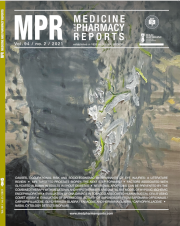Clinical and radiographic evaluation of demineralized freeze-dried bone allograft with concentrated growth factor versus concentrated growth factor alone in the treatment of intrabony defects
DOI:
https://doi.org/10.15386/mpr-1718Keywords:
allograft, concentrated growth factor, periodontal regenerationAbstract
Background. Periodontal disease is one of the major causes of alveolar bone loss. There are various ways of regenerating the lost bone, i.e. guided tissue regeneration, bone grafts, and growth factors. In this purview, it becomes immensely important for a clinician to decide the best modality of treatment. In this study, we compared the effect of demineralized freeze-dried bone allograft (DFDBA) in combination with concentrated growth factors (CGF) verses CGF alone.
Methods. This double-blind, split-mouth study was conducted on ten patients with two comparable bilateral intrabony defects. Each pair of defects was randomly treated by DFDBA + CGF or CGF alone. Clinical parameters such as plaque index (PI), modified gingival index (MGI), pocket probing depth (PPD), and relative attachment level (RAL) were recorded at baseline, three months, and six months. In addition, radiograph with grids was also taken at baseline and six months. The paired t-test was used to compare the pre- and post-treatment values and the unpaired t-test was used to compare the test and control group.
Results. The PI score decreased significantly from baseline to six months. Similarly, the mean MGI score decreased significantly from baseline to six months. The intragroup comparison showed that there was a significant reduction in PPD in both the test and control group. However, the intergroup comparison showed that the reduced pocket depth was not significant. The intragroup radiographic comparison showed that there was the significant formation of bone in both the test and control group but inter-group showed that the formation of bone among both the group were non-significant.
Conclusion. Radiographic and clinical outcomes of this study concluded that post six months, both groups demonstrated significant improvement in clinical and radiographic parameters. However, the addition of DFDBA to CGFs did not give any additional benefits.
Downloads
Published
How to Cite
Issue
Section
License
The authors are required to transfer the copyright of the published paper to the journal. This is done by agreeing to sign the Copyright Assignment Form. Whenever the case, authors are also required to send permissions to reproduce material (such as illustrations) from the copyright holder.

The papers published in the journal are licensed under a Creative Commons Attribution-NonCommercial-NoDerivatives 4.0 International License.

